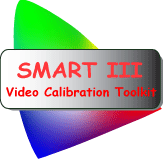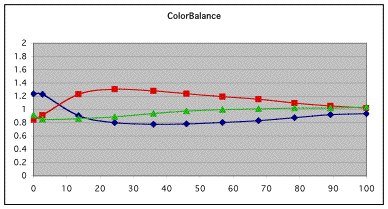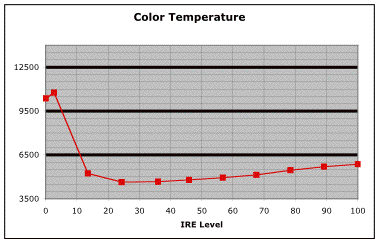SMART III - Video Calibration Toolkit
Steve Smallcombe's SMARTAVTWEAKS site

SMART and Absolute Color Balance
Determining color temperature in an absolute sense is very difficult.
The visible light spectrum from various light sources can be complex.
To get the absolute color temperature and/or CIE coordinates of that light
would require measurements at 100s or more wavelengths, combined with
appropriate weighting or averaging to simulate a standard observer. The
cost of equipment to do this accurately is more than many people are willing
to spend for calibrating projectors for their home theaters.
Many color measurement systems, including those used by many professional
calibrators, sample the spectrum at far fewer points and need to be calibrated
for use with specific types of projectors. One might therefore say calibrations
with such equipment are relative as they are based on a calibration or
a reference.
SMART uses a relatively low cost approach involving RGB filters and a
light meter to measure the light intensity of Red, Green and Blue. As
such SMART can be considered a tristimulus colorimeter. SMART can measure
the color balance of white and the various shades of gray of your projector
and allow you to compare that color balance to a reference. The accuracy
of the comparison depends on several factors including the similarity
the light sources, i.e. the projector's bulb and/or filters, and the colors
we are trying to compare. Fortunately we don't need to measure to whole
gamut of color, just whites and grays and if the projectors use the same
type of bulb as the reference, then the SMART system works very well.
In calibrating the color balance of a display, there are really two issues,
finding the right "absolute" color balance at a single IRE level,
e.g. IRE 70 or IRE 100, and obtaining a consistent color balance at all
IRE levels. At the same time one also needs to maximize the projectors
contrast ratio.
There are several ways of getting the right color balance using SMART.
First, if your projector is one where SMART has a projector specific version,
it means that I have checked out this or a similar projector and the "default
values" supplied with the SMART software and meter will provide you
with a good basis for the color balance of your projector. Each meter
provided with SMART has been individually calibrated using a reference
light source for this purpose. Other ways to determining or checking the
proper color balance are described below.
Once the color balance is achieved, either through calibration of the detector, or by use of the default values, SMART's high dynamic range and excellent sensitivity to low light levels make it an excellent tool for then duplicating this same color balance at all the other IRE levels, including IRE 0. This is what is what is meant by grayscale tracking.
 SMART
measures RGB ratios and report RGB ratios, and all internal calculations
that guide the tweaking are based on these ratios.
SMART
measures RGB ratios and report RGB ratios, and all internal calculations
that guide the tweaking are based on these ratios.
From these RGB ratios, however it is possible to calculate many other metrics including xy chromaticity values and correlated color temperatures as shown below. These data for these particular charts were taken from a Sanyo Z1 spreadsheet at the beginning of calibration and does not represent the projector as ultimately tweaked.

The three charts or diagrams show here show the same information, but in different ways. The SMART color balance chart allows you do directly compare RGB ratios at all IRE levels relative to the reference level at 1. The xy chromaticity diagram shows this same information, but in this case, transformed into the CIE color space. The reference point is shown as the unfilled circle near the middle of the diagram and represents the ideal, D65.
 The
Color Temperature chart shows again the same information, but in this
case, as a “Correlated Color Temperature” calculated from
the above xy coordinates. Note that is Color temperature diagram is probably
the least informative of the three, as the Correlated Color Temperature
is particularly insensitive to green in the regions of color space where
we will be operating. So you may find that during the calibration process,
the Color Temperature may read very close to the desired 6500, but that
the SMART Color indicates that green is either too high or to low. This
is because 6500K does not describe a precise location in color space,
(unlike D65) but in fact, a whole locus of lines that can have significant
variation in the green magenta balance.
The
Color Temperature chart shows again the same information, but in this
case, as a “Correlated Color Temperature” calculated from
the above xy coordinates. Note that is Color temperature diagram is probably
the least informative of the three, as the Correlated Color Temperature
is particularly insensitive to green in the regions of color space where
we will be operating. So you may find that during the calibration process,
the Color Temperature may read very close to the desired 6500, but that
the SMART Color indicates that green is either too high or to low. This
is because 6500K does not describe a precise location in color space,
(unlike D65) but in fact, a whole locus of lines that can have significant
variation in the green magenta balance.
Please note however, the calculation or “estimation” of these
other metrics does not really imply anything positive or negative about
the accuracy of SMART. SMART uses RGB ratios to guide tweaking and the
calculation of these other metrics is added so that the user can relate
his or her results to those published in reviews or determined by other
methods. SMART remains a technique that is based on RGB ratios and a reference,
either the default values provided with the calibrated light meter, or
based on a calibration that you provide as described below. Properly referenced,
SMART is capable of providing an accurate “calibration” of
almost any projector.
Other ways to obtaining a reference for the proper color balance
If your projector has a known good color balance, such as "low"
on SONY projectors, then this is a good source for calibrating the SMART
detector. Note this should only be done when the system is new as bulb
aging will change the color temperature of the projector and render it
less useful as a reference.
Another way of setting the color balance, for say a projector that is
not officially supported by SMART, or as a "reality check" for
any projector, is to compare the color of white from the projector to
a reference light source. I use a SolSource lamp from GretagMacBeth as
one such reference when testing new projectors. The lamp not only has
a Color temperature very close to D65, it also has a very similar spectrum
to daylight. There are other lower cost sources of 6500K lamps including
the Ideal-Lume products. Shine the reference light source on part of your
screen or a Kodak Gray Card, and compare it to an IRE window of similar
intensity. Now, adjust the RGB levels of the projector to get the same
color of white. Now measure that same IRE level using SMART and hit the
calibrate button. You now have a good reference for color temperature!
Introduction to how SMART works
Frequently Asked Questions about SMART
Here is what's new is SMART III version 1.2
The Dummies Guide explains the SMART process in a non-technical way
Buy SMART III at EnhancedHT - your exclusive source for all SMART products
Having trouble? Learn the most common mistakes people make using SMART
Read about using bias lights to improve perceived black levels.
Here are some additional tips for the SONY projectors and solution to common problems.